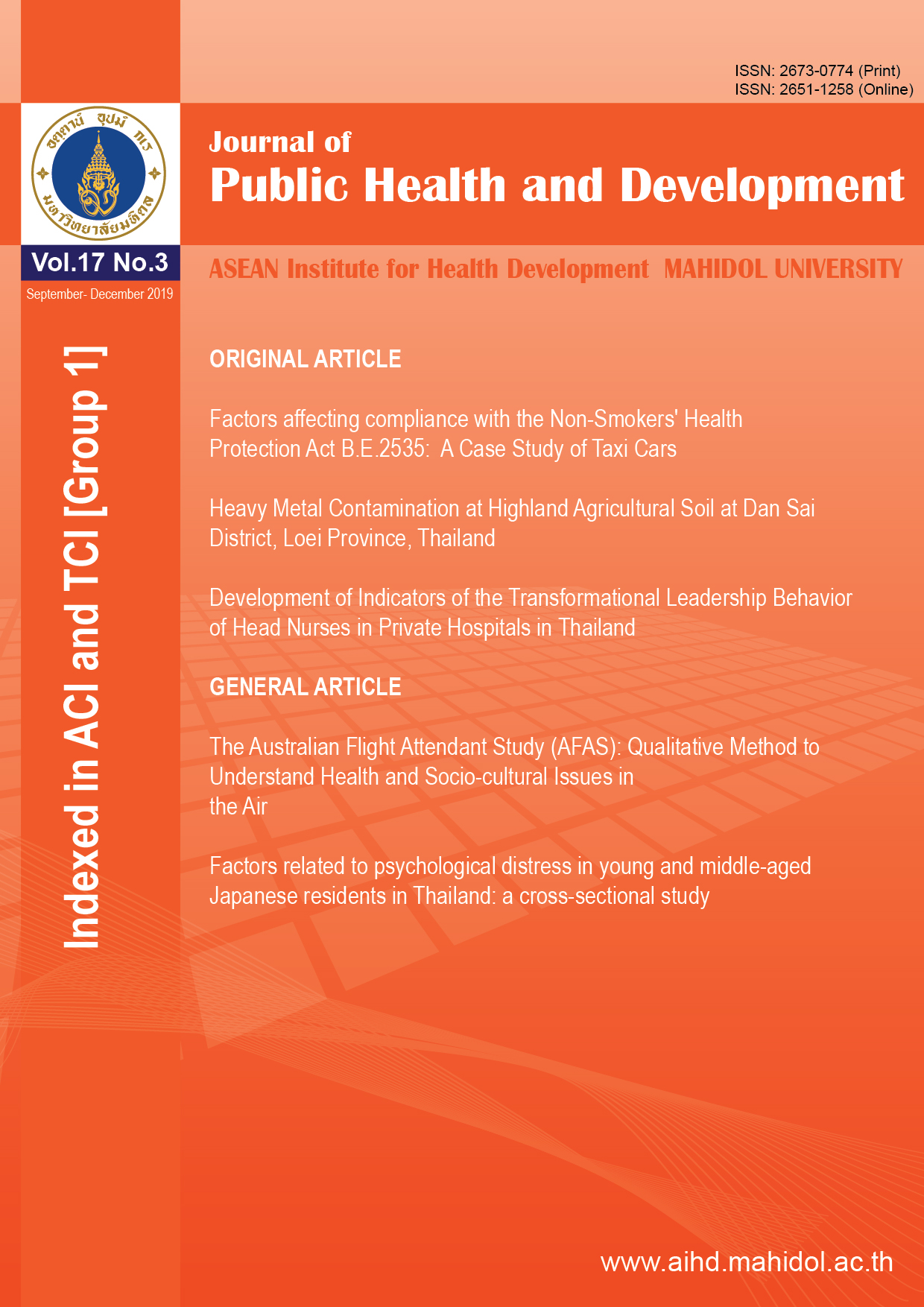Factors affecting compliance with the non-smokers' health protection Act B.E.2535: a case study of taxi cars
Main Article Content
Abstract
Public environment is an important issue for smoking regulation due to the concern of health equity. About 50-60 percent found that public car drivers have risky behavior such as smoking and alcohol drinking which shows that smoking in public transports causes harmful effects to others from exposure to second-hand smoke (SHS). The aim of this present study was to study personal factors, knowledge, attitudes, behaviors and smoking experiences of drivers or passengers and to investigate the correlation between factors and the compliance with the Non-Smoking Health Protection Act B.E. 2535 in drivers and taxi passengers. The data were obtained from self-administered questionnaires responded by 450 taxi drivers and 250 passengers. Statistical analyses were performed for descriptive statistics (demographic data, smoking-related knowledge and attitudes) and Pearson correlation analysis for different factors and smoking behaviors. The results showed that the majority of questionnaire respondents have a sufficient knowledge in law on smoking prohibition and a greater knowledge on harmful effects of smoking. The analysis of factors affecting legal compliance, it is found that attitude to the dangers of smoking was statistically significant (p <0.030) in taxi drivers while smoking behavior of passengers was significantly affected the compliance with the Non-Smoking Health Protection Act (p = 0.001). For further smoking control regulation, the governmental legislation on anti-smoking in public vehicles should be continued. The knowledge of harmful health outcomes associated with smoking should also be promoted to change the attitude toward public smoking.
Article Details

This work is licensed under a Creative Commons Attribution-NonCommercial-NoDerivatives 4.0 International License.
References
Campos T, Richter KP, Cupertino AP, Galil AG, Banhato EF, Colugnati, FA et al. Cigarette smoking among patients with chronic diseases. International journal of cardiology, 2014 174(3), 808-10.
Khani Y, Pourgholam-Amiji N, Afshar M., Otroshi O, Sharifi-Esfahani M, Sadeghi-Gandomani H et al.Tobacco Smoking and Cancer Types: A Review. Biomedical Research and Therapy. 2018;5(4): 2142-59.
World Health Organization. Facsheet: Tobacco. 2018 [online] Available from: https://www.who.int/en/news-room/ fact-sheets/detail/tobacco. [accessed august, 2018]
Patel M, Thai CL, Meng YY, Kuo T, Zheng H, Dietsch B, et al. Smoke-Free Car Legislation and Student Exposure to Smoking. Pediatrics. 2018 Jan;141(Suppl 1):S40-S50.
US Department of Health and Human Services Centers for Disease Control and Prevention National Center for Chronic Disease Prevention and Health Promotion Office on Smoking and Health. 2012 Surgeon General’s report—preventing tobacco use among youth and young adults. 2012. [online] Available https:// www.cdc.gov/tobacco/data_statistics/sgr/2012/. (accessed August 30, 2019)
Johnson KC, Glantz SA. Evidence secondhand smoke causes breast cancer in 2005 stronger than for lung cancer in 1986. Preventive medicine. 2007;46(6): 492-6.
WHO. History of the World Health Organization framework convention on tobacco control. World Health Organization, 2009.
Ritchie DD, Amos A, Shaw A, O'Donnell R, Semple S, Turner S, Martin C. How do policy advisors and practitioners prioritise the protection of children from secondhand smoke exposure in a country with advanced tobacco control policy? Tob Control. 2015;24(1):70-6.
Sooksriwong A. International Law on Smoking Bans in the AEC and Smoking Prevalence Rate. Romphruek Journal. 2014;32(3); 110-32.
National Statistics Office. The smoking and drinking behavior survey 2011. Bangkok: National Statistics Office 2012.
Bangkok mass transit authority. Driver smoking. 2017. Available from https://www.bmta.co.th/th/content/คนขับสูบบุหรี่บนรถ (Accessed December 3, 2019)
Thai health. More than 70% of passengers smoking on trains. 2018, Available from https://www. thaihealth. or.th/Content/45100-%E0%B8%9C%E0%B8%A5%E0%B8%A7%E0%B8%B4%E0%B8%88%E0%B8%B1%E0%B8%A2%E0%B8%8A%E0%B8%B5%E0%B9%89%E0%B8%84%E0%B8%99%E0%B8%9D%E0%B9%88%E0%B8%B2%E0%B8%9D%E0%B8%B7%E0%B8%99%E0%B8%AA%E0%B8%B9%E0%B8%9A%E0%B8%9A%E0%B8%B8%E0%B8%AB%E0%B8%A3%E0%B8%B5%E0%B9%88%E0%B8%9A%E0%B8%99%E0%B8%A3%E0%B8%96%E0%B9%84%E0%B8%9F%E0%B8%81%E0%B8%A7%E0%B9%88%E0%B8%B2%2070%20.html (Accessed December 3, 2019)
Prateepkaew W, Lomprom P and Promchai W. Smoking behavior of youth in Nonthaburi Province Research report Tobacco Control Research and Knowledge Management Center, 2009. (in Thai)
Daniel, W.W. Biostatistics: A foundation for Analysis in the Health Sciences. 9th edition. New York: John Wiley &Sons, 2007.
World Health Organization Framework Convention on Tobacco Control. WHO Framework Convention on Tobacco Control, 2005.Geneva, Switzerland: WHO; 2005. https://www.who.int/ tobacco/framework/WHO_FCTC_english.pdf.
Barnoya J, Navas-Acien A. Protecting the World From Secondhand Tobacco Smoke Exposure: Where Do We Stand and Where Do We Go From Here?. Nicotine Tob Res. 2013;15(4):789–804.
Griffith G. Global Smokefree Partnership; 2010. [online] Global Smokefree Partnership (2010) Article 8 Status Report. Available from : https://www.globalsmokefree.com/gsp/resources/ficheiros/statusreportonarticle8/pdf.
Sirichotiratana N, Yogi S, Prutipinyo C. Perception of Tourists Regarding the Smoke-Free Policy at Suvarnabhumi International Airport, Bangkok, Thailand. Int J Environ Res Public Health. 2013;10(9): 4012–26.
Luo B, Wan L, Liang L, Li T. The Effects of Educational Campaigns and Smoking Bans in Public Places on Smokers' Intention to Quit Smoking: Findings from 17 Cities in China. BioMed research international. 2015; 853418 (2015).
Ashley MJ, Ferrence R. Reducing children's exposure to environmental tobacco smoke in homes: issues and strategies. Tob Control 1998;7:61–5.
Bich N, Cook M, Johnstone K, Capra M, Lan VT. Students' knowledge and attitudes towards smoke-free universities: changes since enactment of Vietnamese tobacco control legislation. Asian Pac J Cancer Prev. 2016;17(S1):65-70
Ravara SB, Castelo-Branco M, Aguiar P and Calheiros JM. Compliance and enforcement of a partial smoking ban in Lisbon taxis: an exploratory cross-sectional study. BMC Public Health 2013;13:134.
Thomson G, Wilson N. Public attitudes to laws for smoke-free private vehicles: a brief review. Tob Control. 2009; 18(4):256-61.

